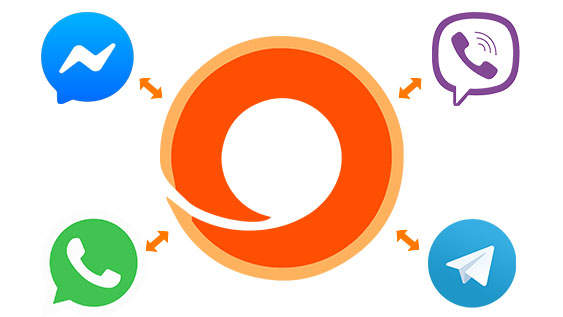Everything You Need to Know About Text Message Marketing Plans
-
What Is a Text Message Marketing Plan?
-
Why Do You Need a Plan?
-
Components of a Business SMS Marketing Plan
-
Key Considerations Regarding SMS Texting
-
How to Find a Business SMS Texting Solutio
What Is a Text Message Marketing Plan?
As a marketer, you no doubt have a marketing plan, budget, and schedule for the year, but does it include text messages? A text messaging marketing plan lays the groundwork for how you will leverage SMS capabilities to reach your audience. It provides the roadmap, complete with elements like strategy, tasks, roles and responsibilities, and timeline. This strategic framework ensures that every message sent aligns with your broader marketing goals and resonates with your target audience.
As part of your overall marketing plan, your text messaging marketing strategy will run concurrently with other digital and non-digital marketing campaigns, such as email, social media, websites, webinars, and print. Each channel takes a different approach and can reach different segments of your audience. Together, they form a comprehensive plan to build brand awareness, excite and engage customers and prospects, promote products and build brand ambassadors, and generate and convert leads.
Implementing a robust text messaging marketing strategy involves more than sending occasional messages. It requires a thoughtful integration of promotional, transactional, and informational content that is timely and relevant. By integrating SMS into your multi-channel strategy, you ensure that text messaging acts as a powerful touchpoint that complements and enhances the effectiveness of other media.
Furthermore, text messaging marketing offers unique advantages, such as immediate deliverability and high open rates, which are crucial for time-sensitive promotions and announcements. The personal nature of SMS also allows for direct engagement with your audience, creating a two-way communication channel that fosters deeper relationships and encourages direct feedback from your customers.
To optimize the impact of your text messaging marketing, consider segmenting your audience to tailor messages that are specific to their needs and preferences. This targeted approach not only improves engagement but also increases the likelihood of conversion, making SMS an invaluable tool in your marketing arsenal.
Why Do You Need a Plan?
According to Gartner, “A marketing plan is incomplete without an effective strategy and strategic plans,” and that includes your texting channel. Over and over again, studies prove why SMS is such a valuable marketing strategy:
-
Americans check their phones every 10 minutes, on average
-
60% of customers read texts within 1-5 minutes after receiving them
-
75% of customers say they want to receive offers via SMS
-
The CTR rate for offer messages is 9.18% higher than any other digital channel.
-
SMS open and response rates are as much as 98% and 45%, respectively
And let’s look at how texting is effective in the higher education sector:
-
50% of students say they don’t read emails from their institutions
-
85% of students report that text messages from their universities promoted them to complete a task, informed them of something they didn’t realize they needed to do, and/or was useful in helping them complete college tasks
But even with these staggering statistics, many organizations simply add SMS as a line item in their marketing plans instead of crafting a dedicated text message marketing plan. There are many ways to take advantage of SMS and various strategies for each. Without a specific plan, you can easily lose sight of your strategy, miss opportunities and drain resources.
Benefits of a Plan
Marketing and sales alignment
Your text messaging plan can serve as a living document that aligns your marketing team with sales. Marketing and sales have the same goal of converting prospects into customers, but each must work in tandem to achieve higher success rates. When developing a marketing plan, you must work with sales data to understand your customer so you can create an effective texting strategy that reaches the right people at the right time with the right messaging.
A clear execution pathway
Just as with a more general marketing plan, your text message marketing plan provides direction to all stakeholders, with defined roles, responsibilities, and timeline per campaign. The plan presents the why, how, and when, while also establishing guardrails to prevent unnecessary risk and to keep everyone on task.
Target market and competitor identification
One of the most important aspects of your general marketing plan is providing a detailed analysis of your target audience and competition. You can include this data in your text messaging marketing plan but go a step further, segmenting your audience to those you want to reach via SMS – those most likely to engage with and respond to texts – segmented further into prospects and customers. Your plan will also help you better understand your competitors’ strategies and performance.
Marketing spend ROI
No matter what you spend on various marketing efforts, it is critical to understand how your investments are paying off. Your texting marketing plan will define key performance indicators (KPIs), such as delivered percentage, open rates, click rates, opt-out/in rates, list growth, and conversion rates. These measurements not only help you justify spend but ensure you are on the right track and optimizing your text messaging strategy.
Components of a Business SMS Marketing Plan
Your text message marketing plan is a microcosm of your general marketing plan, following the same general plan structure. Its purpose is to provide transparency into what it will take to achieve your goals and make sure your delivery is tied to the corporate strategy so your campaign brings value.
You can develop an overall text messaging marketing plan and then include a plan per campaign. Each should include:
-
The goals and objectives
-
The defined target audience
-
How SMS will accomplish your goals and reach your target audience
-
The timeline and budget
-
Specific roles and responsibilities
-
Performance metrics
-
The SMS software platform you will use
-
Any compliance-related requirements, such as opt-in and opt-outs and disclaimers
Of course, your plan should be flexible. Today’s world is highly dynamic, particularly when it comes to digital marketing. Only those organizations with agile strategic plans are able to quickly adapt to changes that can interrupt activities or present opportunities.
For instance, you may have a specific promo in your plan but then see a competitor is running the same campaign before you launch yours. You need to be able to switch direction to create a new campaign or postpone it for later in the year.
Key Considerations Regarding SMS Texting
Short Codes and Long Codes
There are several factors to consider when developing your SMS campaigns. The first is the type of number you need for your campaign.
There are dedicated short codes and long codes, also referred to as 10DLC. Short codes are ideal for high-volume, mass marketing campaigns because, unlike long codes, they have a faster delivery rate and aren’t typically flagged as spam.
10DLC is best for more personal, one-on-one outreach, as customers may recognize the phone number as your brand’s and can respond by texting or calling the number. Customer service can use these 10-digit numbers to directly reach out to and respond to customers to solve their specific issues or establish a personal relationship to boost loyalty.
Ideally, your organization will have both a short code and a long code to use in these various ways. Not all providers offer both, so be sure you ask before signing up.
Opt-ins/Outs
The Federal Communications Commission (FCC) requires all organizations that send text messages to a person to adhere to the Telephone Consumer Protection Act requirements. These laws ensure that consumers have a say as to which SMS text communications they receive from organizations. Whoever sends a message from your organization must comply or the FCC can impose significant per-message fees, and the recipient has grounds for a lawsuit.
Specifically, you must receive customer consent before you can send any message, and you must provide details (fine print) in your printed or digital marketing promo. Your legal “birdseed” should include your organization name, why you are contacting them, how many messages you intend to send, notification of possible carrier costs and fees, and the option to ask for help and opt out of future texts.
Add a call to action (CTA) to your email marketing campaigns, share social media posts with a link to enroll, and find other creative and easy ways to entice subscribers. You can also obtain opt-ins by asking recipients to text a keyword to your short code. When they participate, they automatically agree to opt in to future texts from your organization. Include “Text STOP to End” in at least one message every 30 days, and keep track of responses so you don’t inadvertently send an unwanted text.
How to Find a Business SMS Texting Solution
There are many SMS platforms on the market, but not all offer the same features, ease of use, or pricing. There are a few things to look for when searching for an SMS texting solution to fit into your text message marketing plan.
Cost and delivery speeds are paramount. Find a provider with direct carrier connections to not only speed up the delivery process, discourage spam, and reliably deliver each text message but lower your costs. Without a middleman, you have fewer suppliers to manage and get better rates.
Look for a provider that maintains their own list of people who opted out of your messages so you can be certain to avoid penalties. They will need to keep this list secure, so check to see if they keep the list and all text messages in an ISO 9001 cloud database, the gold standard for security.
Of course, you want a platform that is easy to use. Some platforms are overly complicated and nickel-and-dime you for each add-on feature. Find a simple interface with simple pricing that provides powerful, built-in features that are included in your pricing so you know people will adopt the software and it won’t blow your budget.
Part of that ease of use includes administrative controls. A platform with an online control panel will enable administrators to easily assign and remove access and user privileges, specify types of messages, and monitor all text messages. The interface should provide robust reporting to help you measure those KPIs.
Finally, ask about integrations. Your marketing team and sales reps shouldn’t have to navigate away from their most used business systems, like their CRM, to text customers. Some providers offer a long list of integrations with key business systems, but be sure those integrations don’t require coding on your end. No-code integrations will ensure you can connect systems without IT help while giving users the ability to text straight from the integrated business system.
Building your text messaging marketing plan is worth the time and effort, providing your marketing team and organization with clear direction on how to achieve the greatest return on your investment. By keeping your plan aligned with business goals and measuring performance, you can be certain to continually improve your strategy to get the best results.
Take your SMS marketing to the next level
Schedule a 15 minute Demo todayLearn More
Quick Links
Business SMS
SMS API Integration SMS for Business Communications Enterprise Texting Services Business SMS Shortcode Mass SMS Solutions Short Code TextingSMS Marketing
SMS Marketing Platforms SMS Marketing Services Call Center SMS Services SMS Buyers Guide Short Code SMS Solutions Short Code Messaging ComplianceTrueDialog powers Enterprise-Grade SMS Business Text Messaging for revenue teams to drive engagement across the customer lifecycle, and at scale. Founded in 2008, TrueDialog is a Communications-Platform-as-a-Service (CPaaS) company serving over 2,000 customers in North America that continues to innovate its messaging platform to ensure its leadership position in the industry. The technology is cloud-based and API-centric, powered by an ISO 9001 database and direct carrier connections to deliver 99.9% uptime. Customers use TrueDialog for text message marketing, mass text messaging campaigns, customer service text messaging, and employee communication.
TERMS OF USE | PRIVACY POLICY | WEB ACCESSIBILITY | © COPYRIGHT TRUEDIALOG
 Salesforce
Salesforce





